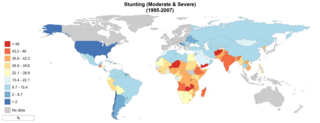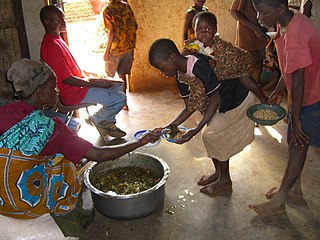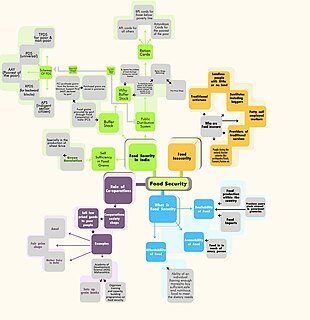A dietitian is an expert in dietetics; that is, human nutrition and the regulation of diet. A dietitian alters their patient's nutrition based upon their medical condition and individual needs. Dietitians are regulated healthcare professionals licensed to assess, diagnose, and treat nutritional problems.
A nutritionist is a person who advises others on matters of food and nutrition and their impacts on health. Some people specialize in particular areas, such as sports nutrition, public health, or animal nutrition, among other disciplines. In many countries, a person can claim to be a nutritionist even without any training, education, or professional license, in contrast to a dietitian, who has a university degree, professional license, and certification for professional practice.

The Mid-day Meal Scheme is a school meal programme of the Government of India designed to better the nutritional standing of school-age children nationwide. The programme supplies free lunches on working days for children in primary and upper primary classes in government, government aided, local body, Education Guarantee Scheme, and alternate innovative education centres, Madarsa and Maqtabs supported under Sarva Shiksha Abhiyan, and National Child Labour Project schools run by the ministry of labour. Serving 120,000,000 children in over 1,265,000 schools and Education Guarantee Scheme centres, it is the largest of its kind in the world.
Micronutrients are essential elements required by organisms in varying quantities throughout life to orchestrate a range of physiological functions to maintain health. Micronutrient requirements differ between organisms; for example, humans and other animals require numerous vitamins and dietary minerals, whereas plants require specific minerals. For human nutrition, micronutrient requirements are in amounts generally less than 100 milligrams per day, whereas macronutrients are required in gram quantities daily.

A school meal or school lunch is a meal provided to students and sometimes teachers at a school, typically in the middle or beginning of the school day. Countries around the world offer various kinds of school meal programs. Each week day, millions of children from all standards and grades receive meals at their respective schools. School meals in twelve or more countries provide high-energy food with high nutritional values either free or at economical rates.
India's population, as per 2011 stood at 1.21 billion. There are great inequalities in health between states. The infant mortality in Kerala is 6 per thousand live births, but in Uttar Pradesh it is 64.
The Special Supplemental Nutrition Program for Women, Infants, and Children (WIC) is a federal assistance program of the Food and Nutrition Service (FNS) of the United States Department of Agriculture (USDA) for healthcare and nutrition of low-income pregnant women, breastfeeding women, and children under the age of five. Their mission is to be a partner with other services that are key to childhood and family well-being. The basic eligibility requirement is a family income below 185% of the federal poverty level. Most states allow automatic income eligibility, where a person or family participating in certain benefits programs, such as the Supplemental Nutrition Assistance Program, Medicaid, or Temporary Assistance for Needy Families, may automatically meet the income eligibility requirements. Currently, WIC serves 53 percent of all infants born in the United States.

Stunted growth is a reduced growth rate in human development. It is a primary manifestation of malnutrition and recurrent infections, such as diarrhea and helminthiasis, in early childhood and even before birth, due to malnutrition during fetal development brought on by a malnourished mother. The definition of stunting according to the World Health Organization (WHO) is for the "height for age" value to be less than two standard deviations of the WHO Child Growth Standards median.
Governance is a broader concept than government and also includes the roles played by the community sector and the private sector in managing and planning countries, regions and cities. Collaborative governance involves the government, community and private sectors communicating with each other and working together to achieve more than any one sector could achieve on its own. Ansell and Gash (2008) have explored the conditions required for effective collaborative governance. They say “The ultimate goal is to develop a contingency approach of collaboration that can highlight conditions under which collaborative governance will be more or less effective as an approach to policy making and public management” Collaborative governance covers both the informal and formal relationships in problem solving and decision-making. Conventional government policy processes can be embedded in wider policy processes by facilitating collaboration between the public, private and community sectors. Collaborative Governance requires three things, namely: support; leadership; and a forum. The support identifies the policy problem to be fixed. The leadership gathers the sectors into a forum. Then, the members of the forum collaborate to develop policies, solutions and answers.
The Central Government of India's social programmes and welfare expenditures are a substantial portion of the official budget, and state and local governments play roles in developing and implementing social security policies. Additional welfare measure systems are also uniquely operated by various state governments. The government uses the unique identity number (Aadhar) that every Indian possesses to distribute welfare measures in India.
Prime Minister Modi’s New 15 point Programme for minorities is a programme launched by Indian government for welfare of religious minorities in furtherance of reports by committees such as the Sachar Committee Report that highlighted that minorities, especially Muslims, in the country were often in a worse socio-economic and political condition than communities such as the Scheduled Casts and Scheduled tribes communities that have been oppressed over millennia through the caste system. It pegged the status of minorities on various indicators such as nutrition, health, education et al. of minorities and specially Muslims at an abysmally poor level. The 15 point program was the government's response to these finding by laying down guidelines to target minorities in schemes and entitlements that are already in place and designing and executing new schemes aimed at the empowerment of these groups. The programme advocated allocating 15% of plan outlays of welfare schemes identified under the 15 point programme.

The Global Alliance for Improved Nutrition (GAIN) is an independent non-profit foundation based in Geneva, Switzerland. GAIN was developed at the UN 2002 Special Session of the General Assembly on Children.

Anganwadi is a type of rural child care centre in India. They were started by the Indian government in 1975 as part of the Integrated Child Development Services program to combat child hunger and malnutrition. Anganwadi means "courtyard shelter" in Hindi.
Health care services in Nepal are provided by both public and private sectors and are generally regarded as failing to meet international standards. Prevalence of disease is significantly higher in Nepal than in other South Asian countries, especially in rural areas. Moreover, the country's topographical and sociological diversity results in periodic epidemics of infectious diseases, epizootics and natural hazards such as floods, forest fires, landslides, and earthquakes. A large section of the population, particularly those living in rural poverty, are at risk of infection and mortality by communicable diseases, malnutrition and other health-related events. Nevertheless, some improvements in health care can be witnessed; most notably, there has been significant improvement in the field of maternal health. These improvements include:
The Ministry of Women and Child Development, a branch of the Government of India, is an apex body for formulation and administration of the rules and regulations and laws relating to women and child development in India. The current minister for the Ministry of Women and Child Development is Smriti Irani having held the portfolio since 31 May 2019.

Despite India's 50% increase in GDP since 2013, more than one third of the world's malnourished children live in India. Among these, half of the children under three years old are underweight.
Integrated Child Development Services (ICDS) is a government programme in India which provides food, preschool education, primary healthcare, immunization, health check-up and referral services to children under 6 years of age and their mothers. The scheme was launched in 1975, discontinued in 1978 by the government of Morarji Desai, and then relaunched by the Tenth Five Year Plan.
Coluthur Gopalan FRCP, FRS, FAMS, FASc was an Indian nutritionist. He was responsible for initiating nutrition research in independent India, leading to a number of interventions such as the Integrated Child Development Services, the midday meal scheme for school children, goiter prevention programme, etc. The burning feet syndrome is also known as Grierson-Gopalan syndrome. While the condition was described in 1826 by a British medical officer James Grierson, Gopalan also described this condition in 1946 when he observed it, "chiefly in females between the ages of 20 and 40 years, among the poor in South India".

School feeding programs have been defined by the World Bank as "targeted social safety nets that provide both educational and health benefits to the most vulnerable children, thereby increasing enrollment rates, reducing absenteeism, and improving food security at the household level". Beyond improvements in access to food, school feeding programs also have a positive impact on nutritional status, gender equity, and educational status, each of which contributes to improving overall levels of country and human development.

The National Food Security Act 2013 is an Act of the Parliament which aims to provide subsidized food grains to approximately two thirds of India's 1.2 billion people. It was signed into law on 12 September 2013, retroactive to 5 July 2013.








